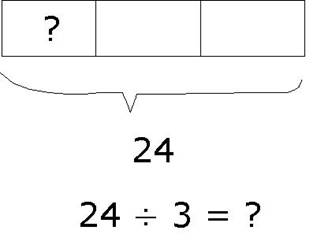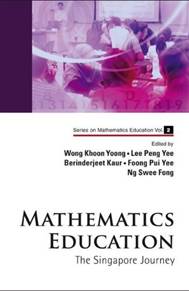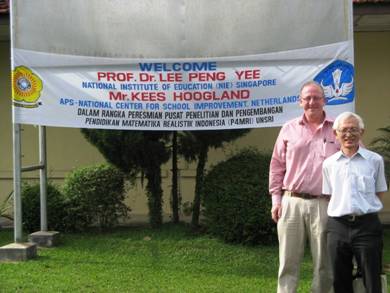|
Singapore |
|
Lee Peng Yee, from mathematics to mathematics education
©Interview by Kees Hoogland, 1 March 2009
S
Introduction
Singapore is a city nation surrounded by Malaysia. It has near to 5
million inhabitants.
Singapore gained sovereignty on 9 August 1965. The official languages are
Malaysian, English, Chinese and Tamil.
Prof. Dr. Lee Peng Yee was born and raised in Singapore, he first was for many years a professor of Mathematics (Analysis) at the National University of Singapore (NUS). Since 1994 he is involved in the National Institute of Education (NIE), which is part of the Nanyang Technical University (NTU), the second largest University in Singapore. The NIE is the only teacher training institute in Singapore for all teachers of primary and secondary education. The following text is a summary of a long talk I had with professor Lee in Palembang, Sumatra.
Education in Singapore
P1 – P6 X1 – X4 --------------------------------- JC1 – JC2 University (3 yr) Teacher training (1 yr) Most children attend Kintergarten before they enter six 6 years of primary education Secondary education is four years (X1 – X4). It has two streams Arts and Sciences. The science stream is bigger than arts stream. There are in secondary education two subject matters regarding mathematics: Mathematics and Additional Mathematics Mathematics is obligatory, Additional Mathematics is optional. Almost all science stream students take on Additional Mathematics.
“So if I visit a primary school the chance is rather big I meet a
teacher I know from NIE and that he/she had additional mathematics
in junior high school.” Two years of junior college prepares students for university. University studies in Singapore take three years. After that you can do one year study at NIE to get a diploma as a certified teachers (Post Graduate Diploma of Education =PGDE). Another route was and is a two years program at NIE after high school, but this route is phasing out, due to the ambition that every teacher has a university degree. One other route is to become a graduate from NIE, that is a 4 year program leading to a grade in Arts and a diploma as a teacher.
Mathematics education
Mathematics in primary education P1 – P6 is called Mathematics. The instruction language in Singapore is English. The national curriculum is called the syllabus. There are syllabi for grades 1 to 4 and one for grade 5/6. At the end of grades 3,4,5,6 there is a national examination (was twice a year from grade 1 to 6).
“Having 10 years of obligatory education and 10 years of obligatory
mathematics creates problems with students with different abilities.
So the math-syllabus is the most differentiated compared to other
subject matters. We do not want a whole lot of drop outs.” In P6 the differentiation starts: there is mathematics and mathematics foundation, which is just a lesser program. The differentiation goes on in all the syllabi in X1 thru X4.
Content of mathematics
Regarding mastering the operations the use of the “model method” is widely used and also “strongly forced to use”. The model method uses a visual representation of operations (also fractions, decimal and ratio). It imprints the visual “geometrical” equivalent of the “algebraic “ operation. It facilitates problem solving. “Did we do prove it worked? Yes. Everyday.” (Lee smiles) An example: http://www.teach-kids-math-by-model-method.com/
Next to that the curriculum dictates to connect the mathematics with societal demands and modern insights. These basics of the curriculum have not changed much over the decades. We keep a rigorous approach to this method. But every ten year we update the curriculum to keep the good things and add modern insights and societal demands. Even if there is no direct need for a change, we modernize it to “shake up the tree”. The effect is that teachers go to in-service teacher training again, publishers make new editions of schoolbooks and there is media attention for education.
“Mind you: if something must be added, some other thing MUST go.
Overcrowded curricula are never working to gain some depth.” In 1981 the primary mathematics
series was published with the “model-method”. In 1999 the content in the curriculum was reduced further in order to provide room for teachers to implement key initiatives (namely the infusing of thinking skills and integrating the use of Information Technology in lessons and the delivery of the National Education messages). Curriculum content were reduced by up to 30% for most subjects. The content removed or reduced from the subject syllabuses includes the following: · Concepts or skills which are not fundamental to the essence of the subject studied or which rely on plain recall; · Content which overlaps with that taught at other levels in the same subject or with what is taught in other subjects; · Content which focuses on technical details rather than conceptual understanding and is no longer relevant in the Singapore context or in real world practice; Content which is too difficult or abstract for the intended level. One of the major chapters removed from Primary Mathematics (Second Edition) was "Division of Fractions". In 2004 was the last review of the syllabi was in 2004, to be implemented in 2006 and 2007, starting in X1 and X3. Mathematics will be more activity based and contextual. And calculators are introduced earlier in primary education (grade 5) and graphic calculators in secondary education. Reviews come about through a series of committees that get smaller and smaller. In the committees are representatives of the Ministry of Education, Teachers, Mathematicians, Mathematics Educators, Parents, etc..
“When you look at the website of NIE of MoE, you can only see what
already is going out. It is more interesting to see what is getting
in.”
“Another trend is downplaying the testing, too much teaching time is
spend on testing. We consider a “through train” for primary
education: 1 exam only in 6 year and next to that school exams. No
national exams any more in P1 and P2.”
More detailed remarks In
the last ten year a serious shift as made in notations especially in
subtraction and division. An example:
Away from the standard algorithms we gave more attention to number
bonds, like: 15
= 10 + 5 15
= 7 + 8
Why we did that? Many complaints over the old way of doing it, and
some new insights to be tried. Most teachers pick this up very
easily, others resist it and hold on to their own tradition.
We
want the students to have more intelligent strategies, p.e. for
6 x 24 We
encourage teachers to focus on intelligent strategies, but it
depends on the teachers.
Some do not buy the idea, because they learned it a different way.
Algebra has been on and off in the syllabus of primary education.
Latest there is a module of pre-algebra, or algebraic thinking:
describe some processes with a formula or a graph (no manipulation).
The use of the calculator has now (2008/2009) been starting to be
used in grade P5 and P6.
Next to modern insights we also hold on to a rigorous approach of
practicing. Problem solving is ok, but you have to be fluent in
basic facts. But students need more than training only. The buildup
of a student for live is more than academic skills.
In
the new curriculum points can be gained by extra activities,
integrated tasks. There is a standard for “National Education”:
things to be learned next to the subject matter, that must be
integrated in the lessons of the original subject matters, sometimes
up to 30%. The last
proposed changes are from the Primary
Education Review and Implementation Committee (PERI). For more
detailed information see
http://www.moe.gov.sg/initiatives/peri/
The key factors in that proposal are: - Balancing knowledge with skills and values, through more engaging teaching methods - New Programme for Active Learning (PAL) - Holistic assessment to support learning
Providing more resources for a quality primary
education, by
References
Lee, P. Y. (2005).
Sixty years of mathematics syllabi and textbooks
in Singapore (1945-2005). Paper presented at the The First International Mathematics Curriculum
Conference, Chicago.
Lee, P. Y. (2006). Mathematics for teaching or
mathematics for teachers. The Mathematics Educator, 16(2),
2-3.
Wong, K. Y., Lee, P. Y., Kaur, B., Yee, F. P., &
Fong, N. S. (2009).
Mathematics
Education, The Singapore Journey: World Scientific Publishing.
National Institute of Education, Singapore
http://www.nie.edu.sg/nieweb/index.do
Mathematics and Mathematics Education academic group
|
 |


